You have /5 articles left.
Sign up for a free account or log in.
There are many soft little things in Louisiana, for such a hard place. Snails, anoles, geckoes, skinks, salamanders, leopard frogs, those other frogs that might be toads -- all risk being stepped on, cut apart by the very shells meant to protect them, smashed in door jambs, run over by car tires. Within hours they’re beautifully jerkied on the concrete under the sun, colors vivid, eyes calm, looking only as if they feel a little flat.
What they’re doing in the doorways, on the sidewalks, driveways, and streets to begin with is obvious. Sometimes if you’re a soft little thing -- a college professor, for instance -- you need to hit the road to see your options.
***
Frenchy met me in Phoenix, and we drove north out of the Sonoran Desert, up through the Mazatzal range and the expansive Tonto National Forest. It was a sunny day, fine for travel, with long views through the mountains, and he asked how far we intended to go in the other direction from my conference in Flagstaff. I decided to break the news slowly and said we were headed toward Albuquerque.
“New Mexico?” he said.
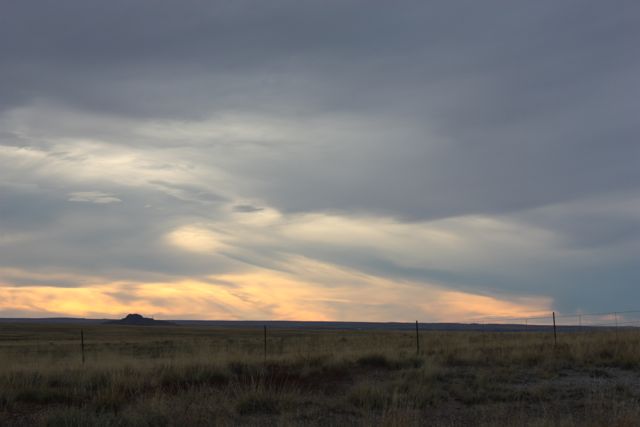 We drove for hours, staring out at the brown and tan desert, rolled out on the Colorado Plateau and headed east on Interstate 40, the old Route 66. Outcroppings of rocks changed in surprising ways every few miles, but I found the landscape monotonous. Geography doesn’t know that; it’s perfect in its own intention, and when my mind began to run away, the intention pulled me back, as if by a string. The human here, as in Louisiana, reflected hardship due to water: In Arizona, too little water at great expense, financially and psychically; in Louisiana, too much water, at even greater expense.
We drove for hours, staring out at the brown and tan desert, rolled out on the Colorado Plateau and headed east on Interstate 40, the old Route 66. Outcroppings of rocks changed in surprising ways every few miles, but I found the landscape monotonous. Geography doesn’t know that; it’s perfect in its own intention, and when my mind began to run away, the intention pulled me back, as if by a string. The human here, as in Louisiana, reflected hardship due to water: In Arizona, too little water at great expense, financially and psychically; in Louisiana, too much water, at even greater expense.
Frenchy said I needed to see the Petrified Forest, a 20-mile detour each way. The Painted Desert was something too, maybe we’d see that a little down the road, but the Petrified Forest: He’d stopped there in 1978. The size and number of trees drowned in a deluge 200 million years ago was astonishing, their broken cross-sections a strange and unexpected kaleidoscope of mineral colors. At the end of the long dirt road in the waning light, when he found the feds wanted $20 to enter the national park, Frenchy told me to do a U-turn around the ranger hut and push on down the road. “You can tell people you were here,” he said. “They don’t have to know you didn’t go in. I’ll even lie for you.”
Back on I-40, a bright yellow water trailer painted with arrows and bloody letters that advertised another “trading post.” A few miles on, the concrete-block gift shop and rock emporium, surrounded by grinning dinosaurs made of amateur fiberglass, necks cracked open to show vertebral wire, chins in the tumbleweed and cactus. A brontosaur like a big green cow, a fiberglass woman bondaged to it in a tangle of rotten lights.
An enormous RV dealership in the middle of the desert, with anything you could want: 18-footers, 26-footers, 28-footers, 30.5-footers, even 40-footers. Signs promised the best prices around. There was nothing around. “You have to drive a long way to get that deal,” Frenchy said. A retired friend of his had bought an RV and planned to drive it around the country but now was thinking of motoring a naval launch he was restoring down the Intracoastal from Virginia, through the Okeechobee Waterway, and across the Gulf of Mexico to Texas. A 20-mile pause. “Frank says you’re more than welcome to ride along on that trip in his open boat,” Frenchy said. “We can roll you off in the water when we steam past Lake Charles.”
“Where are we going in Albuquerque?” Frenchy thought to ask as we drove into the traffic of Albuquerque. I admitted we needed to get up to Santa Fe and, before he could respond, quickly outlined my theory that the problems of trips are like the rigors of form in poetry: Serving the demands of a voyage is the voyage.
“Yeah, I can see that,” he said slowly. “Going to take a look is its own purpose.” He ruminated. Where in Santa Fe, he wanted to know. I said a little north of the city, in the Embudo Valley.
In the end we drove that rental sedan, idiot light aglow and award from the Arizona Highway Patrol on the back seat, until hell wouldn’t have it. We could have driven halfway back to Lake Charles with the miles we covered, or from Berlin to Paris. Of course we also could have flown directly to Flagstaff for the conference and stayed there, but that was not at all the point.
***
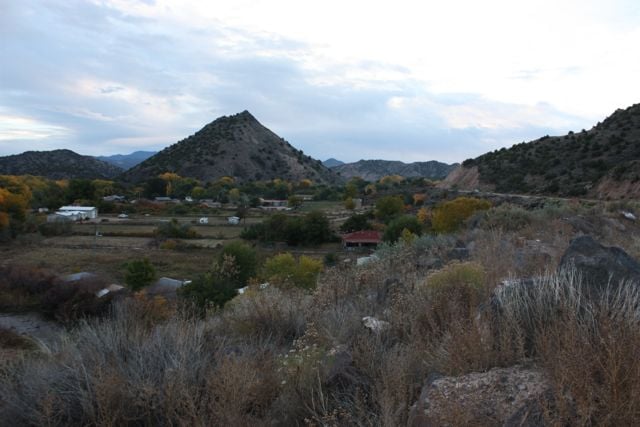 Even when we arrived in the town of Dixon, New Mexico, 20 miles from Taos, we had a little trouble finding Stanley Crawford’s place. Dixon has fewer than a thousand residents living on either side of a single road curving through the low mountains. There are a couple of wineries, a farmer’s market, and several art galleries and artist studios; each November a studio tour draws 2,000 visitors. Frenchy and I drove up and down the road three or four times, his Siri-knockoff addled, not a cell left in its wireless head.
Even when we arrived in the town of Dixon, New Mexico, 20 miles from Taos, we had a little trouble finding Stanley Crawford’s place. Dixon has fewer than a thousand residents living on either side of a single road curving through the low mountains. There are a couple of wineries, a farmer’s market, and several art galleries and artist studios; each November a studio tour draws 2,000 visitors. Frenchy and I drove up and down the road three or four times, his Siri-knockoff addled, not a cell left in its wireless head.
A Merlot sipper stood in the sales room at La Chiripada Winery, slyly hinting at buying a case or two, so I waited for his next pour before I asked the server if he knew the garlic farmer Stanley Crawford. He laughed and said, yeah. He told me to drive out of town and at the bend hang a left on the first county road.
Stan Crawford is the author of 10 books, including three on farming and living where he does: A Garlic Testament: Seasons on a Small New Mexico Farm; Mayordomo: Chronicle of an Acequia in Northern New Mexico; and The River in Winter: New and Selected Essays. He’s been awarded two NEA Writing Fellowships, a Lila Wallace-Reader's Digest Writer's Award, and residencies at the MacDowell Colony, the Bellagio Study Center, and Centrum in Port Townsend, Washington.
Stan’s first novel, GASCOYNE (1966), was written on Lesbos and film-optioned by Richard Lester (Hard Day’s Night). Stan married his wife, Rose Mary, an Australian journalist, on Crete; they moved to Ireland, where they had their first child, then returned to San Francisco in the late ‘60s. Things were so tumultuous, he says, that when friends invited them to northern New Mexico for a visit, they stayed, built an adobe house, began to garden and then farm, and became involved in local life. They’ve been at it four decades.
I first read Stan’s work when Marty Riker at Dalkey Archive Press gave me his cult-classic short novel, Log of the SS the Mrs. Unguentine, which I teach once a year. He’s the kind of writer, I would discover, who inspires long trips to meet him.
When Stan skyped in to my grad seminar recently from his farm in Dixon, we could see blue sky and a northern foothill tantalizingly clearly in the background. Rose Mary leaned in her chair against the house, taking the sun. We discussed how MFA students wonder if they should try to work in academe or take other paths. Though Stan’s taught at times (including the Institute of American Indian Arts in Santa Fe, UMassAmherst, and Colorado College in Colorado Springs), he obviously took a different path, and I asked, for the students’ benefit, if he believed he’d chosen well.
He laughed gently. “Yes,” he said. The last of the movie money was used to buy land for a house, and when the bank required him to own more land in order to qualify for a tractor loan, he got that too. Still, if I was doing the math right, it took only $70,000 in today’s money. Stan agreed it would be nearly impossible, at least in his region, for young people to do the same thing now, as population had swelled, land costs had risen, and there were different notions about its use.
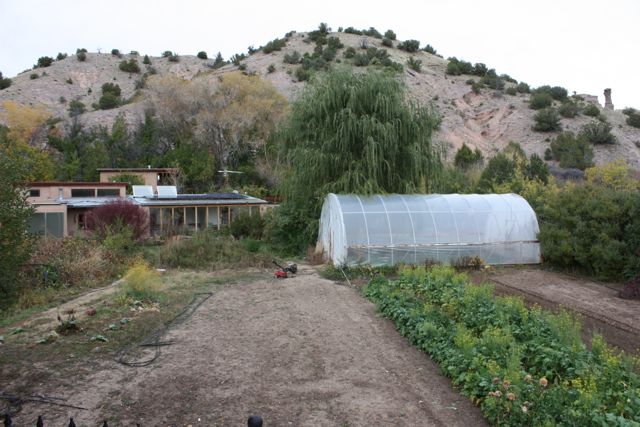 Frenchy and I drove out of Dixon, turned left down through an arroyo and along a dirt lane. One of Stan’s neighbors had a junkyard growing at the front of his property, and Frenchy craned around at the rusting ‘50s hulks and said he’d sure like to walk around in there. The gate to Stan’s farm was so narrow the car barely fit. We drove up the dirt driveway, past a hillock of composted manure, tractors, freshly-tilled dirt, rows of late crops, and a Quonset hoophouse, to the Crawford’s adobe residence. Stan and another man were standing by a pickup, talking. One of the biggest mixed-breed dogs I’ve ever seen was lying in the driveway, and when we’d gotten out of the car, the dog walked straight to Frenchy, put his front paws on his shoulders, and looked him soberly in the eyes. “Tesoro!” Stan called and apologized for the dog. We caught up a little, and Stan invited us to dinner in Taos.
Frenchy and I drove out of Dixon, turned left down through an arroyo and along a dirt lane. One of Stan’s neighbors had a junkyard growing at the front of his property, and Frenchy craned around at the rusting ‘50s hulks and said he’d sure like to walk around in there. The gate to Stan’s farm was so narrow the car barely fit. We drove up the dirt driveway, past a hillock of composted manure, tractors, freshly-tilled dirt, rows of late crops, and a Quonset hoophouse, to the Crawford’s adobe residence. Stan and another man were standing by a pickup, talking. One of the biggest mixed-breed dogs I’ve ever seen was lying in the driveway, and when we’d gotten out of the car, the dog walked straight to Frenchy, put his front paws on his shoulders, and looked him soberly in the eyes. “Tesoro!” Stan called and apologized for the dog. We caught up a little, and Stan invited us to dinner in Taos.
He also took the time to walk us around the farm, which must be a regular job, given his many visitors. He showed us the garlic sorting shed, the greenhouse, the chicken coop, the tower guesthouse with its ¾ cylindrical stone bay that had been, briefly, his writing studio. The guesthouse had a solar array, and behind it was a pond full of cattails that processed graywater. As a working farm it had the vital clutter of rural life around the courtyard—snow shovels, tined forks, milk crates, wood pile, sawhorses gray with age, rusting hatchets and hammers, extension cords, tarps, hand trucks, chain, oil cans, a metal desk with yet more tools and a musical instrument case on top. Drip hoses ran along the garden beds, and a new rototiller stood on a plot of unbroken ground, waiting to be used to death.
Stan’s character Mr. Unguentine is a mechanical genius who creates a seagoing barge so lush it becomes its own ecosystem, as well as the only isolated home for himself and his wife. It may be the last earth on Earth, and the Unguentines its last humans, the close of the Adam and Eve frame tale.
As a visitor walked around the farm, noting its beauty, utility, and near self-containment, he might be forgiven for thinking the fictional Unguentine barge had been modeled on the farm. In fact, it was the other way around:
“Log was unconsciously an imaginative blueprint -- and I emphasize imaginative -- for the lives we would create in northern New Mexico, lives in which we would have at least some control of the basic elements of existence, food, housing, water. […] Log was both an imaginative blueprint and a summary of fantasies about our lives ahead,” Stan says.
(An interviewer once asked Stan, “Why do you think Unguentine continues to garner such fervent devotion and dedicated acolytes some 36 years after its publication?” Stan answered, “[P]erhaps because it's a kind of luxuriant refuge from the world…?”)
One can sense the ingenuity and labor needed to keep the farm, and the toll it would take. “During those intense years -- the 1970s... my attempts at fiction seemed rather pallid in the face of what I was actually living,” Stan says. Here also is the difference between life and a fiction in near-allegorical mode. Stan writes:
Yes, we built our house with our own hands, grew our own food, kept livestock, but what I discovered in Northern New Mexico (and had been long craving) was the social, was cooperation, collaboration, and dialogue about matters political. And of course history is still very much alive here, to perhaps an unusual degree in the States. Raising children was also at the core of all this. Unguentine sought to disentangle himself from the world, from the social and political and historical, and live in the mythical world of self-sufficiency; and if this was to a certain extent an illusion I was attracted to, our early years in New Mexico quickly disabused me of it. Of course the imagination is where one can safely try out such extremes.
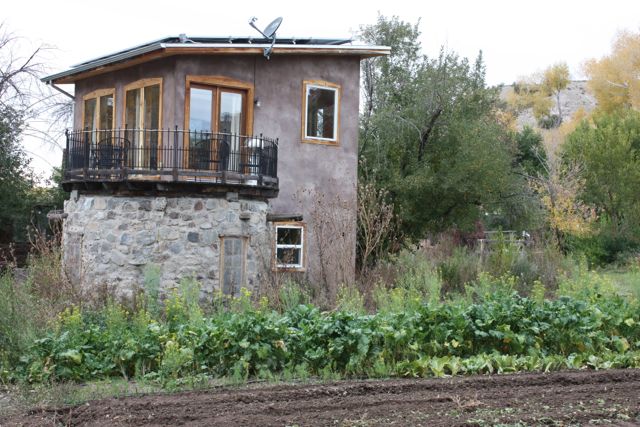 Unguentine disappears in the book, perhaps overboard, leaving his wife in lonely isolation in the middle of the sea. At the farm there is no abandonment, only engagement, with the Crawfords, their farm crew, the market every week, neighbors with whom they’ve had a complicated relationship, two grown children still in the region, and visitors interested in the writing and asking if the enormous carrots still in the ground this late in the season are sweet, not woody.
Unguentine disappears in the book, perhaps overboard, leaving his wife in lonely isolation in the middle of the sea. At the farm there is no abandonment, only engagement, with the Crawfords, their farm crew, the market every week, neighbors with whom they’ve had a complicated relationship, two grown children still in the region, and visitors interested in the writing and asking if the enormous carrots still in the ground this late in the season are sweet, not woody.
Stan and Rose Mary drove us in their electric car to Taos for dinner. The Sangre de Cristos were topped with snow in the sunset. A lovely chat over Chinese food, then we came down again through the dark mountains, through Dixon, and as we turned to cross the arroyo for the farm, Rose Mary sang, “My little road, my little road....” She seemed so happy, so vulnerable. Forty years of hard joy.
“Tesoro, my treasure!” Rose Mary exclaimed when we walked into the Crawfords’ living room. She talked about the adobe floor she had poured, which took forever to dry and multiple patches when it cracked. When she went to the back of the house Tesoro tried to climb on my lap; only his top half fit. Stan, Frenchy, and I talked about writers we knew and books we liked. He asked our plans for the next day and insisted we come up to the house for breakfast at 6:30. We wished him good night and walked a few yards through the garden to the guesthouse. There’d be frost by morning.
Frenchy and I sat up late in the warm guesthouse kitchen and drank the rest of a bottle of Jim Beam we’d brought. We talked and laughed so hard tears squeezed from our eyes.
***
It was country-dark at 6:30 in the morning. The massive adobe fireplace in their house was still warm from the night before. We didn’t want to impose but agreed to a cup of coffee. Rose Mary popped in and said she was going back to bed. I took some pictures with Stan, and he filled a bag with garlic and shallots—some of it planted by now in West Virginia. We said goodbye for now, and Frenchy and I drove out through the narrow gate. None of the lights were on in Dixon, and by the time we were through the mountains to Santa Fe we were eager for more coffee, bacon, eggs, and toast.
A stylish young man welcomed us to the only restaurant we found open. It had high ceilings and a wall of homeopathic additives in canisters like an apothecary’s shop. The menu looked to be vegetarian, much of it gluten-free. Tofu scramble in a granola skillet, kale sauteed with spelt and almond milk. Frenchy, in his flannel shirt and Stihl chainsaw cap, was displeased.
“Here’s your Love Water,” the young man said happily, setting down two juice glasses filled to the brim with snotgreen liquid. I could see Frenchy’s glower in my peripheral vision and couldn’t keep from laughing out loud.
“We give Love Water to everyone for free,” the server said. “It’s cucumber juice, coconut water, silica, celery, cellfood, all kinds of yummy probiotics and our special mix of minerals.... “ He walked back behind the hydration bar.
Being dehydrated and hungry, I took an exploratory sip. It was a little sour, and the coconut and cucumber were separate tastes. Frenchy, trying to make some point, gulped down a third of his glass. His face looked like a Hopi mask. “Love Water?” he bellowed. “This tastes like shit.” I stood; the young man looked at us, confused and hurt. “ I think we’re going to head out,” I said. “Thank you very much.” Later, when 12 hours of cramping, bloating, and gas began, Frenchy slandered the young man and his waters, but I think it was we who were impure.
It rained all day, all the way back to Flagstaff, visibility low and hydroplaning a reality. All the scenic overlooks we’d promised to stop at for photos on the way back were dull, and we kept going. A billboard had Mt. Rushmore on it, President Obama added, but tagged with a Hitler mustache, an X over his face, and a swastika. We passed by Route 66 Knife City, in what appeared to be a former Stuckey’s, the roadside chain where my mother used to let me buy candy cigarettes and divinity.
Frenchy: “At least you can say you were in Arizona that time it rained.”
In A Garlic Testament Stan Crawford writes:
Yet the great danger of living in a small place, in relative solitude, in an almost resistanceless state, lies in formulating generalizations that will readily crumble elsewhere. For this reason I will take the occasional long drive to the West Coast or to another state. Train trips and flights will serve as well, though your passivity as a passenger can lead you into the delusion that the world is an easeful, effortless place. No precise questions are answered by these trips. I am only reminded that this is an enormously wealthy and varied nation, yet also an insensitive and cruel and deadening one, and that to strive for recognition or wealth within it is a disquieting, unceasing labor that will not bring the best out of any man or woman. Better perhaps to seek the contentment of more humble work within the belly of the beast, to inhabit the Pascalian room, to chop your wood, haul your water; better perhaps to stay at home and grow your patch of garlic, and to dream in winter your subterranean dreams, which are always the same: of light, of warmth, and of liberation.
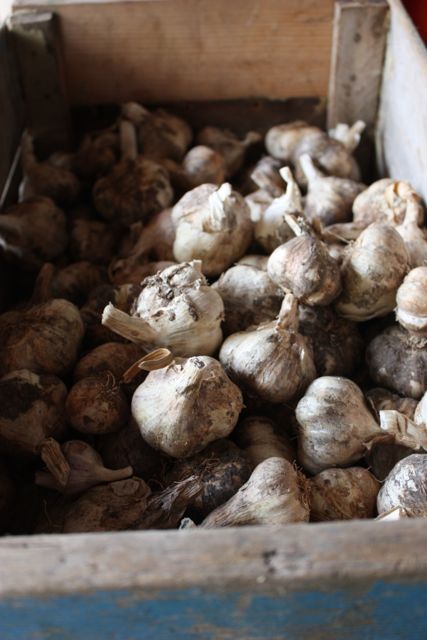 I experienced a moment of joy in the airliner after the conference, no doubt chemical. Those memories one would like to live for again: The smell of dirt under the spring sun in childhood, promise of resurrection. The Panamanian girls screaming with laughter at a friend’s fart, Ay, cochinos! The changing shape of her neck, as she ages. Being read to as a child, now read to by my child. Memories like garlic, pungent little mysteries wrapped in paper.
I experienced a moment of joy in the airliner after the conference, no doubt chemical. Those memories one would like to live for again: The smell of dirt under the spring sun in childhood, promise of resurrection. The Panamanian girls screaming with laughter at a friend’s fart, Ay, cochinos! The changing shape of her neck, as she ages. Being read to as a child, now read to by my child. Memories like garlic, pungent little mysteries wrapped in paper.
And then, just that quick, back to work, humping along the corridor from the temporary library divesting itself of its collections, the air smelling a little like algae in a slovenly aquarium, and a whole lot like something dead.

